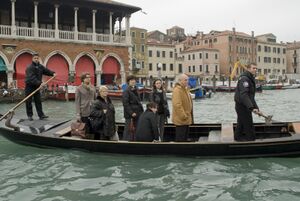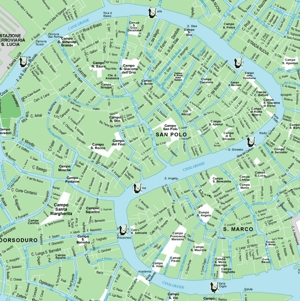Traghetti

Traghetti, plural for traghetto, are traditional ferry crossings used to get across the Grand Canal in Venice, Italy from several locations. A traghetto provides a very time and cost effective means for getting from one side of the canal to the other. They are very convenient, with the average ride lasting merely two minutes, and it is customary to stand for the entire duration. These boats have been utilized by the city as early as the sixteen hundreds, however the number of stations has greatly declined. Today, only seven stations line the Grand Canal.
History of the Traghetti
In the fourtheenth century, there were thirty-seven traghetti in Venice, grouped into three different types: da viaggio (for entering and leaving the city), da bagatin (for crossing the Grand Canal), and per guardagnar (for hire, usually by the day). Each traghetto operated as a guild with a limited number of members, its own rules, or mariegole. The guilds operated much like an independent corporation, electing new members, policing infractions, and fighting turf wars with its neighbors[1]. The earliest of these mariegole belongs to the traghetto of Santa Sofia, dating from 1344[2]. These same regulations held firm into the nineteenth century.
The actual date at which the first traghetto was established is not known, but was certainly in existence in the fourteenth century. This corporation was called a scuola and from the beginning these schools of gondoliers were closely connected to the Catholic church or the parish where the traghetto was situated. The scuole of the past no longer exist today, but the traghetti are still governed by their ancient officials, the gastaldo and bancali[3]. The bancali are still responsible for the order of the men. They arrange rotations of service, oversee the cleanliness and safety of the landing locations, and they retain the powers of trying, fining, or suspending a refractory member. Any other issues with the city authorities, are brought to the attention of the gastaldo and bancali.
Structure of "Gondola"
The boats used at traghetto are robust gondola made to withstand the capacity of around twelve passengers at a time. They lack seating, therefore it is custom to stand for the brief duration of a traghetto ride.
These vessels are typically about eleven meters in length and are constructed with a flat underside. They are built with an asymmetrical hull to increase maneuverability from the stern with one long beech wood oar. There are 280 seperate wooden pieces of wood that are used in the construction of a traghetto, and nine different wood types - beech, cherry, elm, fir, larch, lime, mahogany, oak and walnut. It takes approximately three months to build and around £10,000-20,000[4].
The "gondole" are typically painted black ever since 1562 when Sumtuary Laws were put into effect in order to prevent lavish displays of wealth in their design. Pitch or black tar is used to ensure water tightness and then a gloss finish is applied to complete the design.
Traghetti Routes and Schedules

While traveling by means of traghetti may be cost and time efficient, one must know where the closest ones are and when they operate. There are seven routes for traghetti [5]
Traghetto Prices
Currently, a ride for Venetians across the Grand Canal is €.50, while a ride for tourists is €2.00.
References
- ↑ Davis, Robert C. and Garry R. Marvin. 2004. Venice, the Tourist Maze : A Cultural Critique of the World's most Touristed City. Ewing, NJ, USA: University of California Press.
- ↑ http://www.oldandsold.com/articles07/venice-8.shtml
- ↑ http://www.oldandsold.com/articles07/venice-8.shtml
- ↑ http://www.virtualtourist.com/travel/Europe/Italy/Veneto/Venice-140867/Local_Customs-Venice-Gondole_gondoliere_traghetti-BR-1.html
- ↑ Dunford, Martin. The Rough Guide to Italy . Penguin, 2011. 1040. <http://books.google.com/books?id=FulGBNz35YIC&source=gbs_navlinks_s>.